Understanding the Height of Burj Khalifa: A Detailed Insight
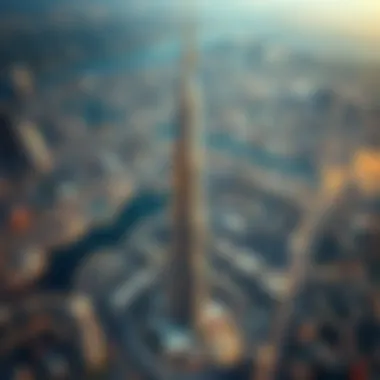
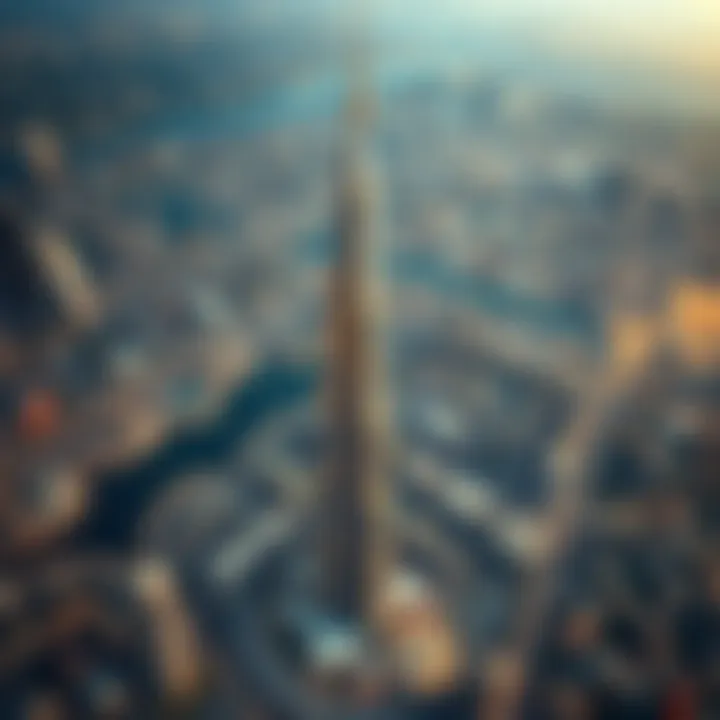
Intro
In the heart of Dubai, where the desert meets the skyline, stands the Burj Khalifa, a towering symbol of ambition and architectural prowess. Known for its breathtaking height, reaching 828 meters, this iconic structure does not just form part of the landscape; it redefines it. As investors eye opportunities and expats seek residences, understanding the implications of this colossal tower extends beyond mere numbers. It embodies a blend of cultural significance, investment allure, and urban transformation that attracts global attention. Grab a seat and let’s delve into how the height of Burj Khalifa shapes its significance in Dubai and beyond.
Market Trends
Current Market Analysis
The real estate market in Dubai has shown a marked growth trajectory in recent years. The presence of the Burj Khalifa strengthens this trend, as it serves as a metaphorical lighthouse for potential investors. The areas surrounding the tower, notably Downtown Dubai, have seen property values swell. As of recent reports, luxury apartments in this district are commanding prices that are on par with those in established global cities like New York and London.
The flood of tourists visiting the Burj Khalifa, combined with a thriving expatriate community, creates a unique dynamic. Properties with a view of the tower or those located within walking distance enjoy heightened demand. The ripple effect is unmistakable: like the ripple of a stone tossed into a pond, the presence of this architectural marvel influences property values in its vicinity.
Future Projections
Looking ahead, analysts predict that the trajectory will continue in an upward direction, provided the economy does not face significant disruptions. Factors such as an increase in tourism and the growing number of expatriates moving to Dubai support optimism. With events such as Expo 2020 being held and further expansions to infrastructural projects, the relevance of the Burj Khalifa in shaping the city’s real estate landscape is expected to grow.
"The Burj Khalifa is more than just a building; it embodies the aspirations of a city fueled by innovation and global engagement."
In Summation
The height of Burj Khalifa isn't merely a statistic; it's a fulcrum for discussions around investment, urban development, and market robustness. For those interested in the realm of real estate, whether as buyers or investors, the insights drawn from observing this iconic structure can serve as valuable signals in navigating the local market.
Investment Strategies
Types of Properties to Consider
Investors eyeing opportunities adjacent to the Burj Khalifa should consider several property types:
- Luxury Apartments: Offering panoramic views and premium amenities, these units remain highly sought after.
- Commercial Spaces: With corporations eager to set up near this symbol of prestige, commercial real estate near the Burj is flourishing.
- Mixed-use Developments: These combine residential and retail spaces, catering to the diverse needs of a vibrant community.
Financing Options and Tips
When navigating the complex world of property finance, here are some strategies:
- Local Banks: Exploring mortgage options through UAE-based banks can reveal favorable terms for expatriates.
- Investment Funds: Consider real estate funds that specialize in Dubai’s burgeoning property market to minimize risk.
- Government Schemes: Research any available initiatives designed to support foreign investors.
In a world keen on measuring success in tangible forms, Burj Khalifa stands tall not just as a symbol of height, but as a beacon of opportunity for savvy investors.
Prolusion to Burj Khalifa
The Burj Khalifa stands as a remarkable landmark in the heart of Dubai. Its height is not just a numerical figure; it embodies the aspirations of a city and a nation, showcasing innovative engineering and architecture. This introduction serves to set the stage for understanding how this towering structure plays a pivotal role in shaping Dubai’s identity and skyline. As we explore the intricacies of the Burj Khalifa, we will uncover various elements that contribute to its significance beyond mere statistics.
Overview of the Burj Khalifa
The Burj Khalifa, completed in 2010, reaches an astounding height of 828 meters, making it the tallest building in the world. Designed by the renowned architectural firm Skidmore, Owings & Merrill, this skyscraper is not merely an architectural feat; it incorporates mixed-use spaces that include residential apartments, office spaces, and even a hotel, the Armani Hotel. Its design is inspired by the desert flower, Hymenocallis, reflecting both the natural beauty of the UAE and the innovative spirit of its people.
In addition, the Burj is surrounded by beautifully landscaped parks and themed gardens, creating a stunning visual experience. Visitors find themselves enchanted by the captivating light shows and the panoramic views from its observation decks. Sipping on a coffee while gazing down at the bustling city below captures the essence of Dubai's blend of modernity and tradition. To summarize, the Burj Khalifa isn’t simply a building; it’s a symbol of what can be achieved through vision and ambition.
Historical Context
Before the Burj Khalifa took shape, Dubai was primarily known for its rich cultural heritage and the lucrative oil trade. The city’s transformation into a global metropolis began in the late 20th century, driven by a desire to diversify its economy. The early 2000s saw an aggressive push in urban development, aiming to position Dubai as a key player on the world map of tourism and innovation.
The idea of the Burj Khalifa was born from this ambition. Initiated in 2004, the construction of the tower faced various challenges, including financial crises and engineering hurdles. Nevertheless, the perseverance of the project team paved the way for its completion. The Burj Khalifa opened its doors on January 4, 2010, during a grand ceremony attended by dignitaries from around the world.
Not only did it become a part of Dubai’s skyline, but the Burj Khalifa also marked a turning point in architectural history and urban development. Its completion has since influenced subsequent projects and sparked a renewed interest in high-rise buildings globally. This historical context illustrates that the Burj Khalifa is steeped in a narrative of growth and resilience, embodying the spirit of Dubai and turning dreams into concrete reality.
Height Specifications

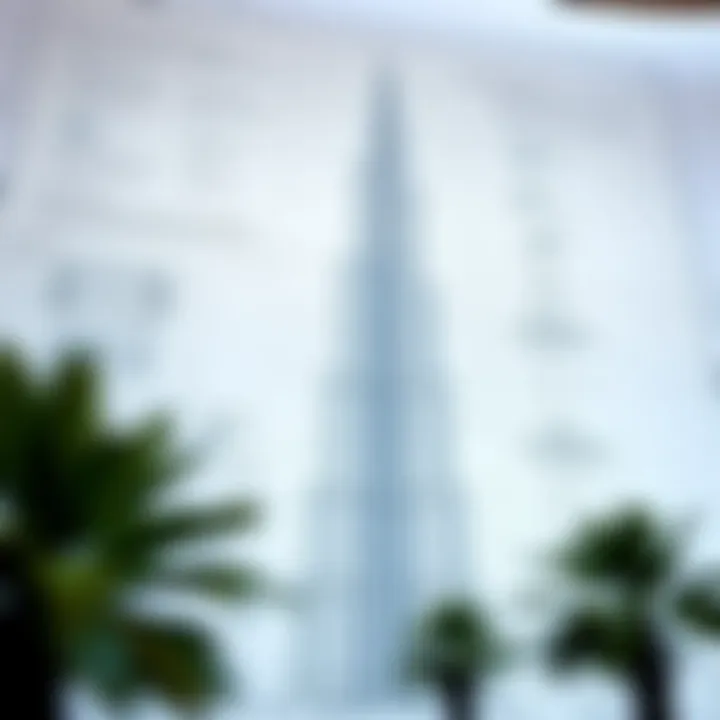
When it comes to the Burj Khalifa, height specifications are more than mere numbers; they encapsulate years of architectural innovation and represent a driving force behind Dubai's identity. The Burj Khalifa stands not only as the tallest structure in the world but also as a symbol of human ingenuity. Understanding its height specifics is crucial for appreciating how this monumental piece of architecture fits into the larger tapestry of global skyscrapers as well as what it means for investors and future residents.
Official Measurement of Burj Khalifa
The official height of the Burj Khalifa is a staggering 828 meters, or 2,717 feet. To put it simply, that’s over half a mile into the sky. The unique measurement is vital to its identity, showcasing the pinnacle of modern architecture. The Burj Khalifa was measured from the ground level to its tip, which includes its antenna.
Other heights have been debated, particularly with regards to architectural height versus structural height. Architectural height includes all integral structures like spires but omits antennas. Structural height, however, accounts for everything, making the Burj Khalifa a wonder by both metrics.
Comparison with Other Tall Buildings
The towering presence of the Burj Khalifa can’t help but draw comparisons with other skyscrapers, like the Shanghai Tower and the Abraj Al Bait Clock Tower.
- Shanghai Tower: Standing at 632 meters, it ranks as the second tallest. Despite its size, it pales in comparison in terms of overall height when pitted against the Burj Khalifa.
- Abraj Al Bait Clock Tower: This building in Saudi Arabia reaches about 601 meters into the sky, which is impressive but still significantly lower.
These comparisons astound not just because of numbers; they reflect a cultural landscape where architectural prowess meets economic ambition. This hierarchy invites investors to view the Burj Khalifa not just as a building but as an extension of Dubai’s meteoric rise.
Metrics of Height Measurement
Understanding how we measure height is as important as the height itself. The methods employed range from the simple to the sophisticated:
- Geodetic Measurements: These refer to measurements made from a point above sea level and take into consideration the curvature of the Earth.
- Triangulation: This technique employs angles to determine distances and heights, a classic method still in play today.
- GPS Technology: Modern tools utilize satellite data to compute heights, giving a level of accuracy unrivaled by earlier measurements.
In discussing metrics, it’s clear that the Burj Khalifa is a product of sophisticated technology and meticulous planning. This speaks directly to investors looking to understand how modern advancements have translated into architectural greatness.
"The height of a building is not just about its stature but also its potential to transform urban landscapes and influence market opportunities."
By revealing detailed specifications about height, we unearth layers of meaning that enrich our understanding of not just the Burj Khalifa, but the broader context of skyscrapers across the globe. Investors, expats, agents, and potential buyers are sure to benefit from comprehending these nuances, particularly as they navigate the dynamic Dubai real estate scene.
Design and Architecture
The design and architecture of the Burj Khalifa play a pivotal role in its identity and functionality. They not only elevate the building's stature but also harmonize with Dubai's vision of modernity and innovation. When we explore this section, we uncover how each design element contributes to the tower's impressive height and overall aesthetic appeal. Understanding these aspects is crucial for anyone who appreciates architecture or is involved in real estate in the area.
Architectural Inspiration
Architecturally, the Burj Khalifa embodies a symphony of influences. The soaring design is inspired by the shape of the hymenocallis flower, which is native to the region. This subtle nod to nature is not just an aesthetic choice but one that reflects the cultural heritage of the area. The tower's three-sided footprint creates an upward spiraling pattern, mimicking the petals of this flower, and making it visually distinctive against the Dubai skyline.
Additionally, the Islamic architecture of the Middle East heavily influences the building's design. The structure’s tapered silhouette mirrors traditional Islamic motifs, while its intricate patterns capture cultural essence without compromising modern functionality. Overall, this blend of symbolism and form results in a striking visual effect that resonates with both locals and tourists alike.
Structural Engineering Components
From an engineering standpoint, Burj Khalifa is an astonishing feat of modern science. It employs a unique structural system known as the buttressed core, which enhances stability and allows for the enormous height of the building. This system consists of a central core surrounded by three wings, providing both support and resistance against high wind loads typical in tall buildings.
These wings extend outward and taper as they rise, creating a beautiful silhouette while also improving structural integrity. In essence, this design not only serves an aesthetic purpose but is also a deliberate strategy to reduce sway and vibration, offering occupants a stable environment even at dizzying heights. Permanent monitoring systems are in place, ensuring that structural integrity is maintained over time, which is crucial given the building's height.
Materials Used in Construction
When it comes to materials, the Burj Khalifa makes extensive use of reinforced concrete, which forms the bulk of its structure. This type of concrete is chosen for its compressive strength, allowing the building to bear heavy loads and resist the pressures exerted by wind. Additionally, approximately 103,000 square meters of glass and 15,500 square meters of stainless steel define the façade, creating a balance of light and shadow that changes with the sun's movement.
Moreover, the use of high-performance concrete enables the building to reach its remarkable height without compromising on quality. Concrete formulations were specifically developed to withstand Dubai's harsh climate while ensuring durability and aesthetic value.
Functionality and Purpose
The functionality and purpose of the Burj Khalifa extend far beyond its impressive height. This is a multifaceted tower that supports a blend of residential, commercial, and tourism activities. Investigating these elements gives a better idea of why the skyscraper has become synonymous with modern Dubai and why it is so crucial to the urban landscape.
The tower stands as a beacon for innovation, a status symbol, and a functional hub effectively merging different sectors. Much like different branches of a tree supporting its growth, the Burj Khalifa showcases how architecture can be both art and utility. This versatility is integral when considering the broader implications of such a landmark on the city and its residents. Let's delve deeper into its mixed-use nature and how that intertwines with community living and commercial opportunities.
Mixed-Use Development
The concept of mixed-use development is fundamental to the Burj Khalifa's design and function. It creates an environment where people can live, work, and play all within the same structure. This adaptability is not merely a design quirk but a pragmatic approach to urban living that addresses the demands of a growing population.
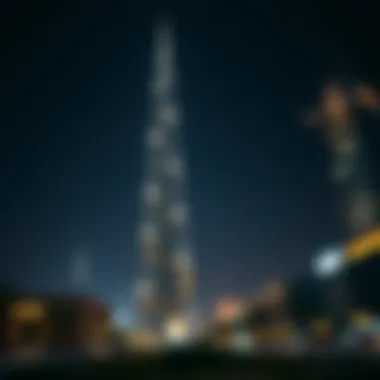

- Residential Spaces: The Burj Khalifa houses luxurious apartments offering stunning views of the cityscape. These residential quarters are designed to provide utmost comfort, boasting high-end finishes and amenities that cater to a cosmopolitan lifestyle.
- Corporate Offices: The tower also accommodates several floors of office space, housing major corporations and multinational firms, making it an epicenter for business in Dubai.
- Recreational Areas: With decks and leisure facilities, the Burj Khalifa provides areas where residents and visitors can relax and take in the breathtaking vistas. This integration promotes a sense of community and enhances the living experience.
The multiple functionalities ensure that the Burj Khalifa serves various demographics—from expatriates and tourists to local citizens—making it a crucial element of Dubai's urban fabric.
"The Burj Khalifa is not just a building; it represents the spirit of ambition and unity within a diverse community."
Residential and Commercial Spaces
The distinction between residential and commercial spaces in the Burj Khalifa sheds light on its holistic approach to urban development. The tower effectively blurs the lines between where people live and where they work, creating an ecosystem that thrives on synergy.
- Residential Benefits: The residential units, which span 900 square meters for some, offer unparalleled luxury—drenched in natural light and fitted with state-of-the-art technology. Living here means enjoying proximity to both work and leisure.
- Commercial Opportunities: The commercial spaces, active with innovation and entrepreneurial activity, cater to a thriving market. Hosting international businesses and start-ups alike, the Burj Khalifa has become a preferred location for business endeavors.
In essence, the functionality and purpose of the Burj Khalifa are inherently linked to its design. By harmonizing residential and commercial areas, it has not only reshaped the skyline but has also significantly influenced Dubai's economy, providing both employment and housing offers that transcend traditional city planning. The Burj Khalifa thus stands as an exemplary model of how a skyscraper can meet diverse needs while elevating the essence of urban living.
Impact on Dubai's Skyline
The Burj Khalifa is not just a tall building; it stands as a monumental emblem of Dubai’s ambition, reshaping the city’s skyline in ways that extend beyond mere aesthetics. The impact this structure has made on Dubai’s urban landscape is profound, as it represents both the historic ambitions of the Emirates and the evolving narrative of modern architecture.
Icon of Modern Architecture
Burj Khalifa has become the poster child of contemporary design, showcasing the potential that modern architecture can achieve when fueled by innovation and creativity. Designed by the acclaimed architectural firm Skidmore, Owings & Merril, this skyscraper blends elements from Islamic architectural traditions with sleek, futuristic lines. Its height, reaching over 828 meters, pushes the boundaries of what was once thought possible in construction.
The building's design is inspired by the shape of a desert flower, aiming to mimic natural beauty, while the exoskeleton structure symbolizes the strength and resilience of urban living in harsh environments. Observers note that its presence commands a unique attention among the iconic structures of the world, making it a crucial reference point in architectural dialogue.
As the tallest structure in the world since its completion in 2010, it has sparked pride among locals and has become a defining element of Dubai's identity. This is evident in how the skyline has shifted from traditional low-rise constructions to extravagant towers that embody both luxury and contemporary engineering. Its silhouette stands as a beacon, drawing architects and engineers who are eager to push the limits of design in line with its innovative ethos.
Tourism and Economic Impact
The Burj Khalifa has had a seismic effect on Dubai's tourism sector. It attracts millions of visitors each year, who come not only to marvel at its architectural prowess but also to experience its observation decks, specifically the At the Top, Burj Khalifa Sky. This hyper-visibility contributes directly to local businesses, from hotels to restaurants, creating a ripple effect that boosts the economy.
- Increased Visitor Engagement: According to estimates from various tourism boards, the Burj Khalifa is one of the most visited landmarks globally, contributing significantly to the overall tourist influx in Dubai.
- Job Creation: The needs of tourists bring jobs across sectors, from hospitality to retail, allowing the city to thrive economically.
- Attracting Investments: The Burj Khalifa serves as a draw for foreign investors considering ventures in Dubai, bolstering real estate and commercial sectors.
Overall, the Burj Khalifa's influence on both culture and tourism is undeniable. The remarkable blend of art and science within its framework encourages an ongoing comic of interest, situating it at the heart of Dubai's continuous evolution as a global hub.
The Burj Khalifa exemplifies not only what architectural ingenuity can achieve but also how such innovations can redefine cultural landscapes and economic fortunes.
As Dubai moves forward, the visible influence of Burj Khalifa will likely persist, guiding how future constructions blend functionality with aspiration. The transformation of the skyline is an ongoing story with this iconic tower as its focal point.
Burj Khalifa and Real Estate
Burj Khalifa serves as not only an architectural marvel but also as a significant catalyst in shaping the real estate landscape of Dubai. The sheer height and modern aesthetics of the tower appeal to both residents and investors, driving attention towards property within the vicinity.
The impact of the Burj Khalifa on real estate goes beyond mere admiration; it extends into economic dynamics and market positioning for properties. Following the completion of the Khalifa, the surrounding areas experienced a boom in property value, driven by demand for luxurious living and office spaces. This tower stands as a beacon indicating where investment opportunities lie in a market teeming with growth.
Influence on Property Values
The real estate market surrounding Burj Khalifa has been significantly impacted since its inception. Properties that were once considered average have become premium assets, often demanding higher prices due to their proximity to this iconic structure. Various studies showed that apartments located near Burj Khalifa appreciate at rates much higher than those farther away. It’s not just about the building itself, but also the lifestyle it represents.
"The Burj Khalifa is more than a tall building; it’s a brand that elevates property values especially in its vicinity."
When individuals think of making a home in Dubai, the allure of living next to a world-famous landmark naturally drives property seekers toward buildings in these prime locations. This has led to an increase in demand for properties around the tower. Additionally, commercial spaces benefit greatly, as businesses desire to situate themselves close to this symbol of opulence.
Overall, properties within close measure of Burj Khalifa often see a premium associated with their value, resulting from the tower’s cultural significance.
Investment Opportunities
Investors eyeing Dubai's real estate market can find abundant opportunities as influenced by the Burj Khalifa. Given its stature, developments nearby are often at the forefront of upscale living, attracting affluent individuals and expatriates alike. High-end apartments and premium office spaces in the area are not only functional, but represent a lifestyle choice that many desire.
The Dubai Land Department has reported steady growth in transactions around the Burj Khalifa, indicating robust investor interest. The influx of tourists also supports rental properties around this landmark, yielding impressive returns for property owners.
Investing in properties here is seen as not just a transaction, but a long-term strategic move. Potential buyers may consider various types of investments:
- Residential apartments with luxurious amenities.
- Commercial spaces suitable for high-profile businesses.
- Short-term rental properties catered to visitors.
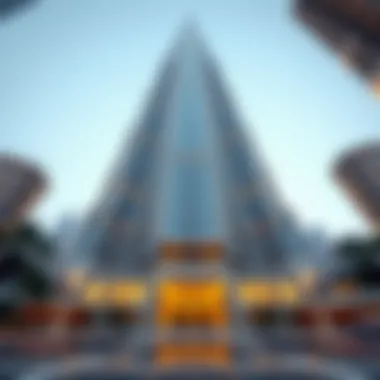
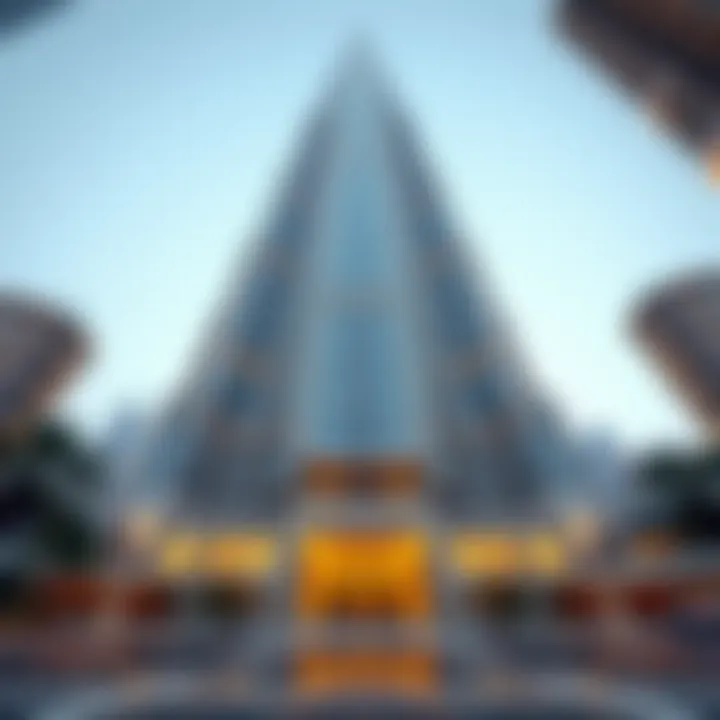
The strategic positioning of Burj Khalifa in global discussions surrounding architecture and urbanization equates to more than just elevated property values; it indicates a thriving market and a significant opportunity for those looking to invest in a promising future.
Cultural Significance
The Burj Khalifa stands tall not only as a feat of engineering but also as a beacon of cultural importance. In the context of this article, examining the cultural significance of the Burj Khalifa entails understanding how it embodies the aspirations of a city, serves as a symbol of identity, and reflects broader societal values. This edifice transcends mere height; it tells a story about ambition, innovation, and the modern Arab experience.
Symbol of Progress
When people think of modern architecture, the Burj Khalifa often comes to mind. It’s not just about its staggering height; it represents progress on multiple fronts. Dubai, a city once known primarily for its desert landscape, has transformed into a global hub for trade, tourism, and finance. The construction of the Burj Khalifa showcases this transformation, highlighting the shift from traditional economic activities to a future-oriented vision.
Its presence has ignited an entrepreneurial spirit, spurring investments and attracting international businesses. The tower symbolizes what can be achieved through cooperation and vision, standing as a testament to the potential of the region. As such, it plays a pivotal role in shaping Dubai's identity as a city where the impossible becomes possible.
"The Burj Khalifa is a testament to what visionary thinking can achieve. It shows that with collaboration and ambition, even the sky is not the limit."
Representation in Media
The Burj Khalifa has become a prominent icon not only within the United Arab Emirates but across the globe, frequently featuring in various forms of media. This representation reinforces its significance, extending its influence beyond architectural circles. From movies to documentaries, the tower has appeared in numerous contexts, often symbolizing luxury and modernity.
In popular culture, it is often used as a backdrop for luxurious lifestyles or grand celebrations, like the annual New Year’s Eve fireworks that draw crowds from all over the world. In films, it has been portrayed as a site of adventure and spectacle. Such portrayals elevate its status, embedding it deeply in the collective consciousness of audiences everywhere.
The media also play a crucial role in shaping perceptions around urban development. Coverage of its construction and subsequent impact has spurred discussions about sustainability, profit, and urbanization. This attention helps potential investors and tourists gauge the cultural and economic landscape of Dubai, fostering a connection that goes beyond just visiting a towering structure.
Thus, the Burj Khalifa, in its multifaceted representations, encapsulates the essence of a dynamic city—with all its challenges and triumphs—leading us to reflect on our own societal aspirations.
Environmental Considerations
The Burj Khalifa stands not only as a towering feat of engineering but also embodies a commitment to environmental sustainability in an age where climate change awaits no one. Many tend to overlook that a building of such scale can have profound ecological implications, both positive and negative. The management of these challenges has become a focal point of discourse among investors, residents, and urban planners who understand that sustainability can coexist with spectacle.
A few key aspects define the importance of environmental considerations in the context of Burj Khalifa:
- Energy Efficiency: One of the foremost practices integrated into the design and construction of Burj Khalifa is energy efficiency. The building incorporates sophisticated systems for energy management, which significantly minimizes electricity consumption. This not only lowers operational costs but also reduces its carbon footprint notably.
- Water Conservation: Water is vital in Dubai, a city characterized by its arid conditions. The Burj Khalifa employs advanced technologies for water conservation. For instance, it utilizes a treatment system for recycled wastewater, which is then utilized for irrigation of the surrounding green spaces.
- Sustainable Materials: The choice of materials in constructing such an imposing structure also plays a critical role in its environmental footprint. Many components were sourced and engineered with sustainability in mind to ensure minimal waste production and the longevity of the materials used.
"Sustainability isn't just a trend; it's a necessity for urban development. Burj Khalifa shows that the tall can be green."
- Impactful Urban Planning: The project involved extensive urban planning strategies designed to promote public transport and minimize congestion. Burj Khalifa is centrally located to encourage visitors and residents alike to use public transport rather than rely on cars, reducing emissions and contributing towards a more sustainable urban ecosystem.
- Biodiversity Integration: In addition to just its structure, the surrounding landscape was meticulously crafted to enhance biodiversity. By incorporating native flora, the area is more resilient to local climate conditions and nurtures the indigenous habitat.
In summary, while the Burj Khalifa captivates with its height, the environmental considerations taken during its construction shed light on a crucial aspect of modern architecture. This sophisticated balance between grandeur and responsibility can be a yardstick for other developments worldwide. As investors, expats, agents, buyers, and renters become increasingly aware of these facets, they are likely to appreciate not only the structure itself but the thoughtful ecological legacy it strives to create.
Sustainability Practices
When discussing sustainability in terms of the Burj Khalifa, it is essential to highlight distinct practices that contribute to its architectural brilliance and environmental responsibility. These practices showcase how a landmark can lead the way in the sustainable architectural movement.
- Low Energy Curtains: The space is outfitted with special low-emissivity glass that helps reflect heat and maintain comfortable indoor temperatures without straining the cooling systems.
- Efficient Systems: The heating, ventilation, and air conditioning (HVAC) system is designed to be highly efficient, ensuring energy is not wasted as it optimally adjusts to indoor climate conditions.
- Smart Building Technology: The Burj Khalifa incorporates smart technology for building management. Sensors regulate energy use and optimize systems in real-time, enhancing both the user experience and environmental footprint.
- Green Roof Features: The top floors include a green roof area, which not only contributes to carbon offsetting but also functions to insulate the building and manage stormwater runoff effectively.
- Ongoing Monitoring: Environmental audits and assessments are conducted regularly to assess the performance of the various systems in place, ensuring any areas needing improvement are promptly addressed. This ongoing commitment reflects the ethos of adaptive management.
Through these sustainability practices, the Burj Khalifa sets a high benchmark, allowing it to blend aesthetic achievement with responsible resource management. Investors and stakeholders will increasingly focus on such developments, recognizing that sustainability and luxury can indeed go hand in hand.
Future Developments Around Burj Khalifa
The Burj Khalifa is not just a landmark; it's a catalyst for growth in Dubai. Understanding the planned future developments around this iconic tower is essential for investors, residents, and urban planners alike. These projects aim to enhance the utility of the area, creating a more vibrant urban environment while solidifying Dubai's position as a global center for business and tourism.
Upcoming Projects
Several analytical studies indicate that developments near the Burj Khalifa are poised to redefine Dubai's skyline further. Some notable projects on the horizon include:
- Dubai Creek Tower: This tower is slated to surpass the Burj Khalifa in height. Designed to resemble a lily flower, it will be a centerpiece for the new Dubai Creek mixed-use development, set to include hotels, residential units, and shopping plazas.
- The Lagoons: An ecosystem of vibrant neighborhoods will rise around man-made lakes and lush greenery. This initiative focuses on providing a sustainable, integrated community experience with easy access to leisure and retail.
- Dubai Metro Expansion: Enhancements to public transport will link the Burj Khalifa closely with new investments in urban infrastructure. This expansion will include additional metro stations and express lines that reduce travel time.
Such projects are pivotal not only in increasing property values but also in enhancing the overall allure of the area.
Influence on Urban Planning
The Burj Khalifa has already shaped the urban planning landscape in Dubai. Its presence has necessitated a reevaluation of urban design principles, prompting a focus on verticality, mixed-purpose spaces, and incorporating nature into densely populated urban centers.
- Sustainable Urban Environment: Planners now emphasize sustainable practices in new developments surrounding the Burj Khalifa. This includes energy-efficient buildings, the incorporation of green roofs, and landscaping that preserves Dubai's natural environment.
- Multi-Modal Connectivity: Urban planners are increasingly recognizing the necessity of interlinked transport networks. The foresight to design walkable areas and promote accessibility is vital in managing increased foot traffic from tourists and locals.
- Public Spaces: Future initiatives are directed towards designing public spaces that promote community interaction, cultural events, and recreational activities, diversifying the area beyond mere commercial use.
Future developments are not just about constructing new edifices; they represent a holistic approach to urban living, fostering a community-centric environment that caters to residents and visitors alike.



